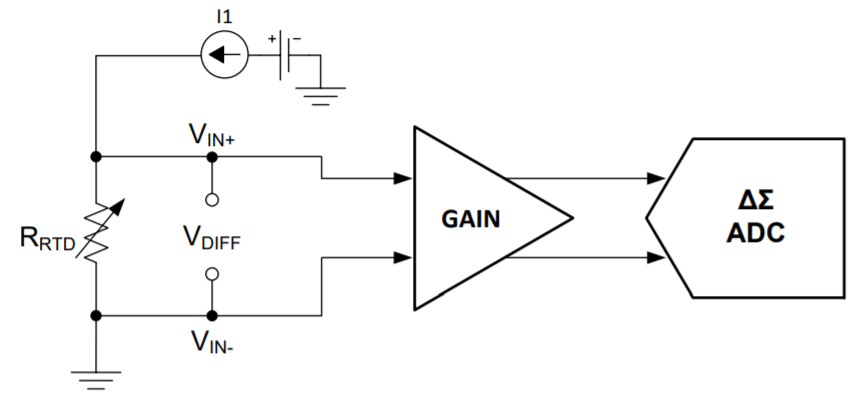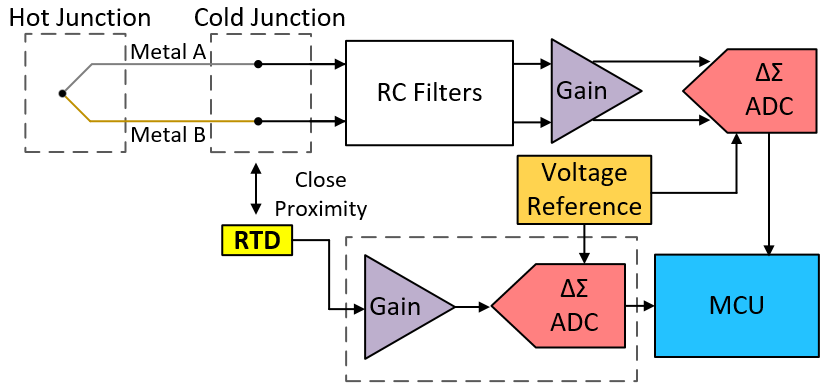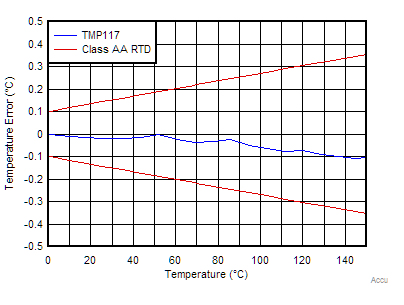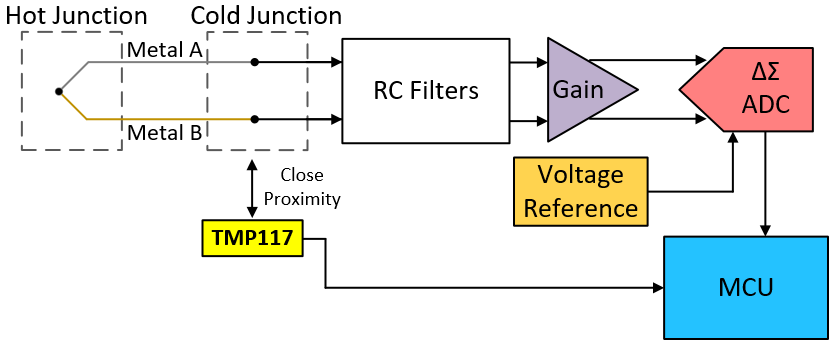SNOAA27 March 2019 TMP117
1 TI Tech Note
Field transmitters are used extensively in factory automation and control-to-sense process parameters like temperature, pressure, and flow rate, to name a few. The sensors used in the field transmitters are mostly analog sensors that must be sampled accurately using an analog front-end (AFE).
Due to the operational conditions that arise from the placement of the field transmitters, it may be subjected to wide varying temperature conditions and hence, require some form of temperature compensation. Traditionally, accurate temperature sensors like Platinum resistance temperature detector (RTD) are used in such temperature compensation systems.
RTDs are most commonly used temperature-sensing components in industrial applications where high accuracy and longevity is desired.
Most RTD applications use a current source to excite the RTD element and create a voltage difference across the RTD, as shown in Figure 1. This voltage is proportional to the resistance of the RTD and the excitation current. The voltage potential is amplified, converted to a digital output by an ADC, and then fed into an MCU where a lookup table is used to convert the digital output to temperature.
 Figure 1. Basic RTD Circuit
Figure 1. Basic RTD Circuit RTDs in Cold Junction Compensation Systems
Thermocouples are temperature-sensing devices that cover a large temperature range and are made by joining wires of two different metals. Due to seebeck effect, the output voltage is approximately proportional to the difference in temperature between the hot junction and cold junction.
Because the thermocouple measures a differential temperature, the temperature at the cold junction must be known to determine the temperature at the hot junction—this process is known as cold junction compensation (CJC).
Platinum RTDs are popularly used to measure the temperature of the cold junction due to their high accuracy. Figure 2 shows a block diagram of a cold junction-compensated thermocouple system using an RTD reference.
 Figure 2. CJC Using RTD System Block Diagram
Figure 2. CJC Using RTD System Block Diagram However, while the system block diagram looks quite simple, there are a lot of considerations like noise, self-heating, and placement considerations that must be carefully analyzed. Also, RTDs are sensitive to trace routing and the trace lengths must be matched. A lot of these considerations may be optimized to reduce complexity and cost by replacing RTDs with temperature-sensing ICs like the TMP117 digital temperature sensor.
Replacing RTD With TMP117 Digital Temp Sensors
The TMP117 is a digital temperature sensor designed for low-power, high-accuracy applications. The device provides a 16-bit temperature result with a resolution of 0.0078°C, along with a factory-calibrated performance of ±0.1°C across –25°C to +50°C or ±0.3°C across the full operating range of –55°C to +150°C, which exceeds the accuracy of a Class-AA RTD. Figure 3 depicts the results of an oil bath experiment conducted on the TMP117. The graph shows that TMP117 can meet the accuracy of a thin film Class AA RTD for a CJC application.
 Figure 3. TMP117 vs. RTD Accuracy
Figure 3. TMP117 vs. RTD Accuracy The TMP117 features a shutdown mode where the device aborts the active running conversion and enters a low-power shutdown mode where it typically consumes 250 nA of current mitigating the effects of self-heating. When triggered by an MCU, the TMP117 can perform quick, 15.5-ms temperature conversions using the one-shot conversion mode with active current as low as 3.5 μA for a duty cycle of 1 Hz. The output is a direct temperature read which does not require any linearization. After completing a one-shot conversion, the device automatically returns to low-power shutdown mode. This simplifies the software implementation versus an RTD, eliminating the need for calibration, external circuitry, matched traces, and Kelvin connections.
The TMP117 also features a fast mode (400 kHz) I2C communication and an offset register that automatically applies a user-defined offset to the measurement results prior to an MCU read. These specs make the TMP117 excellent for low-power consumption requirements in CJC applications for field transmitters.
As described earlier, the TMP117 is comparable in accuracy to the Class AA thin-film RTD and consumes a fraction of the power of a PT100 RTD, when used in CJC applications. Figure 4 shows the block diagram for CJC systems using the TMP117 to replace the RTDs. The systems using the TMP117 eliminates the need for additional components, such as delta-sigma ADCs, programmable gain amplifiers, and RC filters, than the systems using RTD elements reducing the overall system cost. At the same time it reduces complex layout considerations because of a digital read out.
 Figure 4. CJC Using TMP117 System Block Diagram
Figure 4. CJC Using TMP117 System Block Diagram | COLLATERAL | DESCRIPTION |
| TMP117 | ±0.1°C Accurate Digital Temperature Sensor with Integrated NV Memory |
| TMP116 | ±0.2°C Accurate Digital Temperature Sensor with Integrated NV Memory |
| Application Report | RTD Class-AA Replacement With High-Accuracy Digital Temperature Sensors in Field Transmitters |
| Application Report | Replacing Resistance Temperature Detectors With the TMP116 Temp Sensor |
| Application Report | Precise Temperature Measurements with TMP116 |